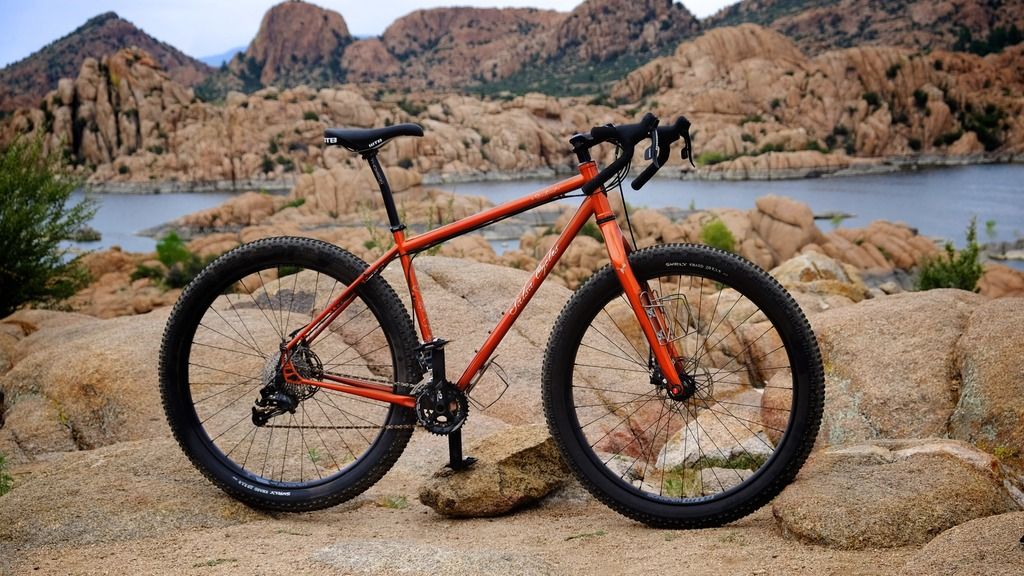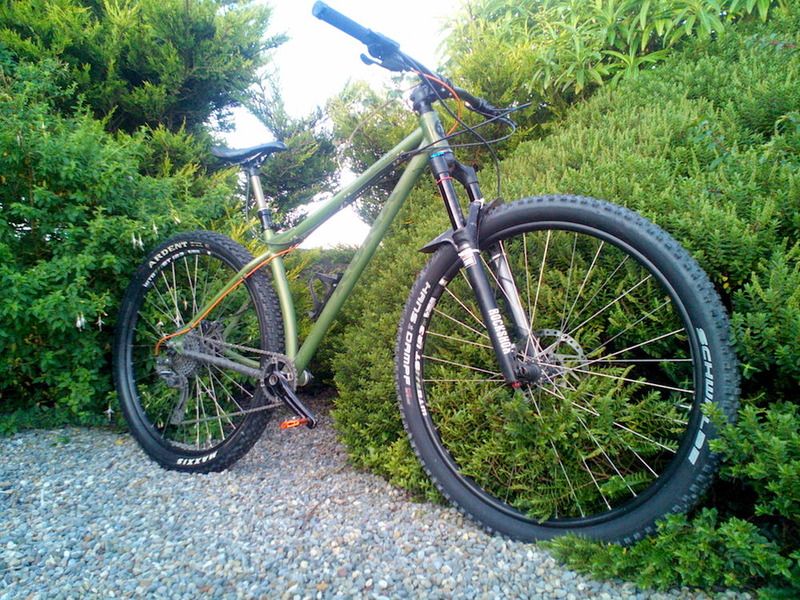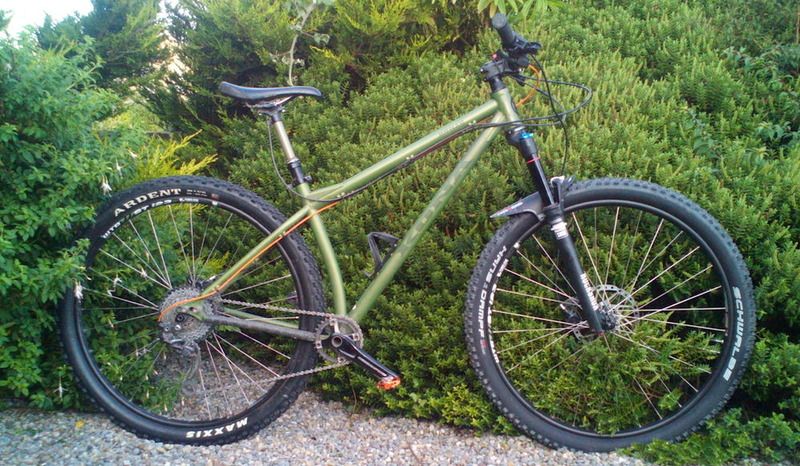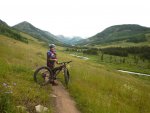You are using an out of date browser. It may not display this or other websites correctly.
You should upgrade or use an alternative browser.
You should upgrade or use an alternative browser.
The ExPo Mountain Bike Photo Thread
- Thread starter Christophe Noel
- Start date
Christophe Noel
Expedition Leader
Getting started is easier than you might think, once you start to assemble the basics. I haven't added to this series in a while, but you might take a look at it:Chris, I'm up in Flag. If you ever feeling like teaching or bringing another rider into the fold of bikepacking, I'd love to tag along for a weekend. Unfortunately I've got little bikepacking kit.
http://www.expeditionportal.com/forum/threads/114335-Bikepacking-The-Expedition-Portal-Series
Biker John
New member
YotaPilot
Adventurer
My diversion for the next few weeks:

Salsa Deadwood 29plus. Radness.
This is a ridiculously fun bike. I can't wait to load it up and hit the road. I've got a route in mind for mid August in Colorado that is perfect for this bike.
Im excited about this bike as well. I'm looking forward to reading your review. I hope you take it on some routes that are not "perfect" for the bike as well, to see what it is really capable of. I'm also curious to see what you think of the carbon fork. I was surprised by that when I saw it.
usadventureracing
Adventurer
Salsa, long haul trucker

Sent from my SAMSUNG-SM-G890A using Tapatalk

Sent from my SAMSUNG-SM-G890A using Tapatalk
usadventureracing
Adventurer
Correction, Salsa Disc Trucker
Sent from my SAMSUNG-SM-G890A using Tapatalk
Sent from my SAMSUNG-SM-G890A using Tapatalk
Christophe Noel
Expedition Leader
Im excited about this bike as well. I'm looking forward to reading your review. I hope you take it on some routes that are not "perfect" for the bike as well, to see what it is really capable of. I'm also curious to see what you think of the carbon fork. I was surprised by that when I saw it.
Although I've only got about 175 miles on the Deadwood, I've easily put over 4,000 on my two Fargos, with probably half of that on rough gravel and singletrack. So, I feel I can speak with confidence about the Deadwood's aptitude at this point.
The only place where bikes like the Fargo and Deadwood begin to feel out of place is on long stretches of mildly technical singletrack, particularly on long descents. I feel they can handle the slower speeds of the climbs in this type of terrain, but once pointed downhill, a couple factors come into play. The first of which is the demands that braking places on the rider. Avid BB7s are fine brakes, but when paired to road levers, they don't exactly offer the most powerful leverage. To really get the full command of the brake lever, you really have to be in the lower, more aggressive, drops. You just can't power on the brakes from atop the hoods...safely.
So, when the trail gets gnarly with lots of steep sections littered with roots, rocks and things that require constant braking vigilance, your only hand position is in the drops, which isn't bad, but not nearly as ideal as a wide flat bar. Even with wide Salsa Woodchipper 2 bars, that drop position is pretty narrow for that type of technical riding. I will say, the extra tire width of the Deadwood not only helps braking traction, it makes the ride more compliant and controlled. Modulating BB7s with road levers in tough singletrack gets tricky.
With regard to the carbon fork, it's a beautiful pairing to the Deadwood. I swapped out this same fork on my Fargo with a Rock Shox Carbon WC SID suspension fork, and it needs it for rough singletrack descents. The Deadwood could be fun with a suspension fork, but thus far I don't think it needs it. The fork doesn't limit it's technical singletrack prowess nearly as much as the bars do. But, don't take that as a strike against the bars. When they're in their element, they are the perfect choice.
In short I'd consider Deadwood turf to look like: (Comparing Fargo to Deadwood, to say a Spearfish)
Pavement: Rolls way better than you think it would, but the extra tire meat is not best used on tarmac. (Advantage Fargo)
Gravel: Same. Nice fast rolling bike with comfy compliance. (Advantage Fargo)
Doubletrack and Jeep road: This is the turf of the Deadwood. The compliance of the tire is the big factor in logging big miles of rough road. (Advantage Deadwood)
Mild Singletrack: This is also the turf of the Deadwood, but there will be some compromises made over a standard mountain bike with straight bars. (Advantage Deadwood/Spearfish)
Technical Singletrack: The Deadwood does great on the ups. You just have to be patient and attentive on the downhills. (Advantage Spearfish)
I fully anticipate riding more singletrack on the Deadwood than I did with the Fargo, and already have. The difference is incredible when it gets technical, but I don't think the Deadwood would be anyone's first choice as a singletrack ripper. I will say, it rides just as superbly fully loaded as it does with just one bottle. Such a fun bike.
In short, the ideal miss-mash of terrain for a Deadwood includes pavement, gravel, doubletrack, mild singletrack and even technical singletrack if you are careful with the long downhills as they will not be fast or fun. I'm talking long, multi-mile downhills with technical elements.
Last edited:
YotaPilot
Adventurer
Wow, thanks for the thorough reply so soon. Thanks for the comparison to the Fargo as it is a bike I have been considering for my next purchase.
When questioning the carbon fork, I was questioning more against a steel fork than a suspension fork. I'm a recent steel convert (Miyata 1000) and I love the suppleness of it. I worry about the durability of carbon when riding off road remotely, as well as the stiffness. I know there are plenty of proven carbon mountain bikes out there, but for me, if I'm getting a steel frame,I want the whole bike to be steel. My fear would be a tip over on a rocky trail and the potential of cracking the carbon. With steel you would at worst have a dent, but still rideable.
Thoughts?
When questioning the carbon fork, I was questioning more against a steel fork than a suspension fork. I'm a recent steel convert (Miyata 1000) and I love the suppleness of it. I worry about the durability of carbon when riding off road remotely, as well as the stiffness. I know there are plenty of proven carbon mountain bikes out there, but for me, if I'm getting a steel frame,I want the whole bike to be steel. My fear would be a tip over on a rocky trail and the potential of cracking the carbon. With steel you would at worst have a dent, but still rideable.
Thoughts?
Christophe Noel
Expedition Leader
Again, having logged probably a thousand or more miles, even racing, with the steel Fargo fork, I think the carbon fork is vastly superior. Anyone who asserts steel in this application is superior is probably preaching from a pulpit steeped in "steel is real" hyperbole more than anyihing. The supleness of steel fork has more to do with the guage of the steel and the shape of the blades than it does the material itself. The steel firestarter fork is not in my mind, a supple fork. The carbon version, is however far stiffer and more accurate in a hard steer.
Co-opski
Expedition Leader
Snip....
The only place where bikes like the Fargo and Deadwood begin to feel out of place is on long stretches of mildly technical singletrack, particularly on long descents. I feel they can handle the slower speeds of the climbs in this type of terrain, but once pointed downhill, a couple factors come into play. The first of which is the demands that braking places on the rider. Avid BB7s are fine brakes, but when paired to road levers, they don't exactly offer the most powerful leverage. To really get the full command of the brake lever, you really have to be in the lower, more aggressive, drops. You just can't power on the brakes from atop the hoods...safely.
So, when the trail gets gnarly with lots of steep sections littered with roots, rocks and things that require constant braking vigilance, your only hand position is in the drops, which isn't bad, but not nearly as ideal as a wide flat bar. Even with wide Salsa Woodchipper 2 bars, that drop position is pretty narrow for that type of technical riding. I will say, the extra tire width of the Deadwood not only helps braking traction, it makes the ride more compliant and controlled. Modulating BB7s with road levers in tough singletrack gets tricky.
...snip
Flounder,
Could you just add inline brake levers like the I've seen on cyclocross bikes?
http://www.parktool.com/blog/repair-help/in-line-brake-levers-cross-levers
The only downside is, I could see them getting in the way of your bar bag/roll.
Christophe Noel
Expedition Leader
Yes, and it's not a bad idea. I have run top-levers on a number of my bikes and they do help to some degree, but the caveat is, you are moved inward even more towards the center of the bars when under extreme braking. It's by no means a wide position on the bars, but it does get you more upright.Flounder,
Could you just add inline brake levers like the I've seen on cyclocross bikes?
http://www.parktool.com/blog/repair-help/in-line-brake-levers-cross-levers
The only downside is, I could see them getting in the way of your bar bag/roll.
And yes, a bar bag becomes an issue.
p nut
butter
Correction, Salsa Disc Trucker
Sent from my SAMSUNG-SM-G890A using Tapatalk
Correction: Surly Disc Trucker.
Nice bike. My wife loves hers.
Co-opski
Expedition Leader
Here is my latest machine, 2014 Kona Honzo 29"


It came with some upgrades, 140mm RS Revelation, 32t Raceface narrow wide, SLX brakes and a dropper post.
Made a few changes to it, hope 40t expander ring, Candy pedals, Hans Dampf front tyre, tubeless conversion, scored some Magura MTS 2015 brakes on ebay for a song.
The steel frame is really forgiving, and while I still notice i'm riding a hard tail, I feel no jarring like is common with alu hard tails. Short chain stays and fairly aggressive geometry make this bike great fun to throw around, and helps cover up the fact that it has big wheels. Find it more manoeuvrable than my XC bike on switchbacks when climbing, but not nearly as fast going up the hills. Took a bit of getting used to the 1x10, but a few rides, and a bit of practice of grinding in the big ring on the road bike and it feels a lot nicer now.
Next I think i'll cut the bars down a bit and put on a shorter stem, seems to have a bit of an ape hanger feel to it at the moment with the 760mm bars


It came with some upgrades, 140mm RS Revelation, 32t Raceface narrow wide, SLX brakes and a dropper post.
Made a few changes to it, hope 40t expander ring, Candy pedals, Hans Dampf front tyre, tubeless conversion, scored some Magura MTS 2015 brakes on ebay for a song.
The steel frame is really forgiving, and while I still notice i'm riding a hard tail, I feel no jarring like is common with alu hard tails. Short chain stays and fairly aggressive geometry make this bike great fun to throw around, and helps cover up the fact that it has big wheels. Find it more manoeuvrable than my XC bike on switchbacks when climbing, but not nearly as fast going up the hills. Took a bit of getting used to the 1x10, but a few rides, and a bit of practice of grinding in the big ring on the road bike and it feels a lot nicer now.
Next I think i'll cut the bars down a bit and put on a shorter stem, seems to have a bit of an ape hanger feel to it at the moment with the 760mm bars
Similar threads
- Replies
- 22
- Views
- 4K
- Replies
- 0
- Views
- 493
- Replies
- 1
- Views
- 748




